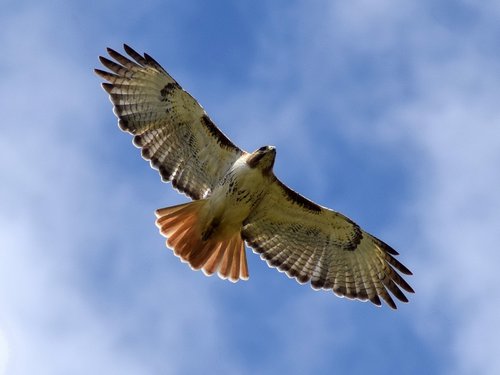Tips to Watch and Identify a Red-Tailed Hawk

Think you’ve spotted a red-tailed hawk? Here are some helpful hints when determining if that raptor you see is of the red-tailed variety.
- Size and Shape: Red-tailed hawks are large hawks with very broad, rounded wings and a short, wide tail. The red-tailed hawk can grow up to 22” long, with a wingspan of up to 53”. To put that into perspective, the bald eagle, one of the largest birds in North America, grows up to 38” long with a wingspan of 80”.
- Sound: The red-tailed hawk has a unique raspy scream that lends itself to the big screen. Whenever you see a hawk or eagle in a television show or movie, the shrill cry you are hearing is almost always a red-tailed hawk. If you hear a shrill call on the Syracuse University campus, look up, because SU-Sue or Otto may be overhead!
- Color Pattern: Most red-tailed hawks are brown above and pale below, with a streaked belly. The tail is usually pale below and cinnamon-red above.
- Behavior: You’ll most likely see red-tailed hawks soaring in wide circles high in the air. In high winds they may face into the wind and hover without flapping, eyes fixed on the ground. They attack in a slow, controlled dive with legs outstretched.
- Habitat: The red-tailed hawk is a bird of open areas. SU-Sue and Otto nest on the Syracuse University campus thanks to its open spaces like the quad. The many tall buildings and trees also make for great nesting and perching locations.
Enraptured by raptors? Remember these tips for a great experience.
- Keep binoculars handy. Red-tailed hawks often exhibit different behaviors during courting and nesting times.
- Let them be. Avoid going near nests, especially during the early summer when hawks have eggs or hatchlings to care for. They will abandon their nests if they feel disturbed or harassed.
- Call the experts. If you see a baby hawk falling out of its nest, contact your local wildlife authority, who will determine how best to help. Similarly, if you discover a sick or injured adult, don’t try to touch or feed it. Again, contact your local authorities.
- Heads up! Hawks perch on tree limbs, telephone poles or buildings (such as on the Syracuse campus) to look for prey, which they swoop down on—sometimes over human heads!
- Watch your outdoor pets. Hawks can carry off up to their own weight (about four pounds). Be watchful of cats or other small outdoor pets.
- Check the app. Looking to instantly identify the species of bird you just photographed? Download the free Merlin bird-identification app from the Cornell Lab of Ornithology. Its photo-ID feature allows you to snap a photograph on your device and the app provides you with a short list of possible matches.
Sources:
National Audubon Society, the Cornell Lab of Ornithology and All About Birds
